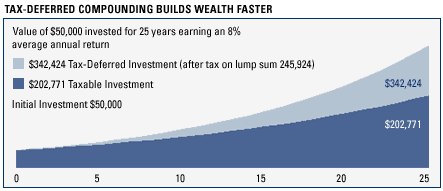The most important benefit of an annuity is tax-deferred growth, which can help your money grow faster than a taxable investment earning a similar return.
You pay no taxes on annuity earnings until they are withdrawn. This means all your money keeps working for you without being reduced by annual taxation. Later when you need your money, only your earnings are taxed.
Your money can grow more quickly in an annuity due to three-way compounding. Your purchase payments, their earnings, and amounts that you would otherwise have paid out in taxes all remain in your account to grow and compound over time.

The chart below shows two hypothetical $50,000 investments: taxable and tax deferred. Both earn 8% a year for 25 years. Over that time the taxable investment grows from $50,000 to $202,771, but the tax-deferred investment grows to $342,424-a difference of $139,653.
The taxable investment is assumed to pay a combined federal and state tax rate of 28% each year on investment returns. Taxes are eventually due on the tax-deferred investment when you begin to withdraw income, but even then, the tax-deferred investment still comes out ahead. If you withdrew all of it as a lump sum after 25 years and paid a combined 33% federal and state tax, the tax-deferred investment would be worth $245,924-or $43,153 more than the taxable one.1
|